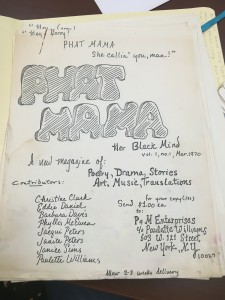Archives and Feminism
Thanks so much to Jennell, Laura and Makaria for last week’s lively discussion! Although Jennell had her own archival adventure at a street fair, we will begin our collective archival journey today. We are visiting The Ntozake Shange Collection ON HER BIRTHDAY!!!! (Don’t forget that we are meeting in the new archive space in Milstein–directions below). In addition to Barnard librarians and archivists, Shannon O’Neill and Vani Natarajan, we will hear from Steven Fullwood, a documentarian, archivist and writer, is also the former Assistant Curator of the Manuscripts, Archives & Rare Books Division at the Schomburg Center for Research in Black Culture, New York Public Library, the founder of the In the Life Archive and co-editor of Black Gay Genius. I got to know Steven in connection with his work founding the Hip Hop/Rap archive at the Schomburg; he is passionately committed to archives as both a political and community practice. His knowledge of New York City archives is broad and deep–we are fortunate to have him again as a resource for the Worlds of Ntozake Shange!
We won’t be discussing this week’s readings during this session, but I want you to get into the habit of thinking about the historiography and( warning, weird video ahead) periodization of multiracial feminist alliance while experiencing the Ntozake Shange Collection and other archival spaces. I also want you to think about women’s movements rooted in other traditions than black feminism (hence the Havlin reading) In class we are focusing on publishing (formal and informal) as one of “those autonomous feminist institutions,” (Thompson 348) being built in the 70s and 80s, but you will see that Shange participated in many others. Some questions to consider: what passions, preconceptions and desires are you bringing to the archive? Once you have found an archival “object” that sparks your interest, how will you economically contextualize it for your audience? How will you move beyond “finding images that illustrate your paper” mode that is typical in academic papers? What is your audience? One of my preconceptions is that I agree with Becky Thompson (and I think, Shange) that the principles of multiracial feminism “remain a blueprint for progressive, feminist, antiracist struggle in this millennium” (349), so my sense is that your stories will be aimed at your peers, but your freedom dreams might teach me otherwise.
Additionally, both articles give you some knowledge about possible creators, timeframes and material (see Fox podcast) to begin searching in the archives. Thompson in particular gives you the names of many feminist and nationalist organizations in which women were active. Once you are in the archive, the materials can lead you to more names, For example, the magazine, Phat Mama that Zake and other Barnard women created is an early example of feminist publishing and it lists names that you might look for in other collections if you were interested in that period of Barnard history. In the upcoming weeks, when you listen to Alta talk about the process of independent publishing, consider the skills these women had to learn to create feminist space in print. To me, the title Phat Mama speaks both to black womanhood and to how early the sense of poetry as an embodied practice appears in Shange’s work. It also makes me wonder how many other black women might have been publishing feminist work at their colleges.
Directions to the Barnard Archive:
Our reading room is located on the 4th Floor of the Milstein Center for Teaching and Learning (MCTL); here is a map of campus. When you enter through the main campus gates on 117th Street, take a right on the brick pathway and follow it to the MCTL, the building to the left of the lawn. When you enter the MCTL, immediately take a right to go down the hallway to the elevators (an attendant’s desk and classrooms will be on your right; the double set of doors on the left is to the elevator vestibule). Take the elevator to the 4th floor. When you get off at the 4th floor, make a left. Immediately in front of you is the Archives reading room. This is where you’ll do your research. Here is a floor plan of the 4th floor, with the Archives reading room and offices shown in orange.
Sorry I forgot to sticky this post!


